PR Practitioners on Managing Stakeholder's Needs in Business
VerifiedAdded on 2023/06/13
|9
|2840
|215
Essay
AI Summary
This essay discusses the crucial role of Public Relations (PR) practitioners in managing stakeholder needs and expectations, emphasizing the integration of Corporate Social Responsibility (CSR) activities. It highlights how PR professionals strategically communicate CSR initiatives to various stakeholders, fostering trust and enhancing the company's reputation. The essay details the steps involved in aligning PR and CSR, from identifying problems and opportunities to implementing and evaluating strategies. Effective stakeholder management is presented as essential for business success, with PR practitioners serving as liaisons between companies and the public, managing communications, and building strong relationships. The essay underscores the importance of understanding and addressing stakeholder expectations to ensure long-term business growth and sustainability. Desklib offers a platform to explore similar solved assignments and resources for students.
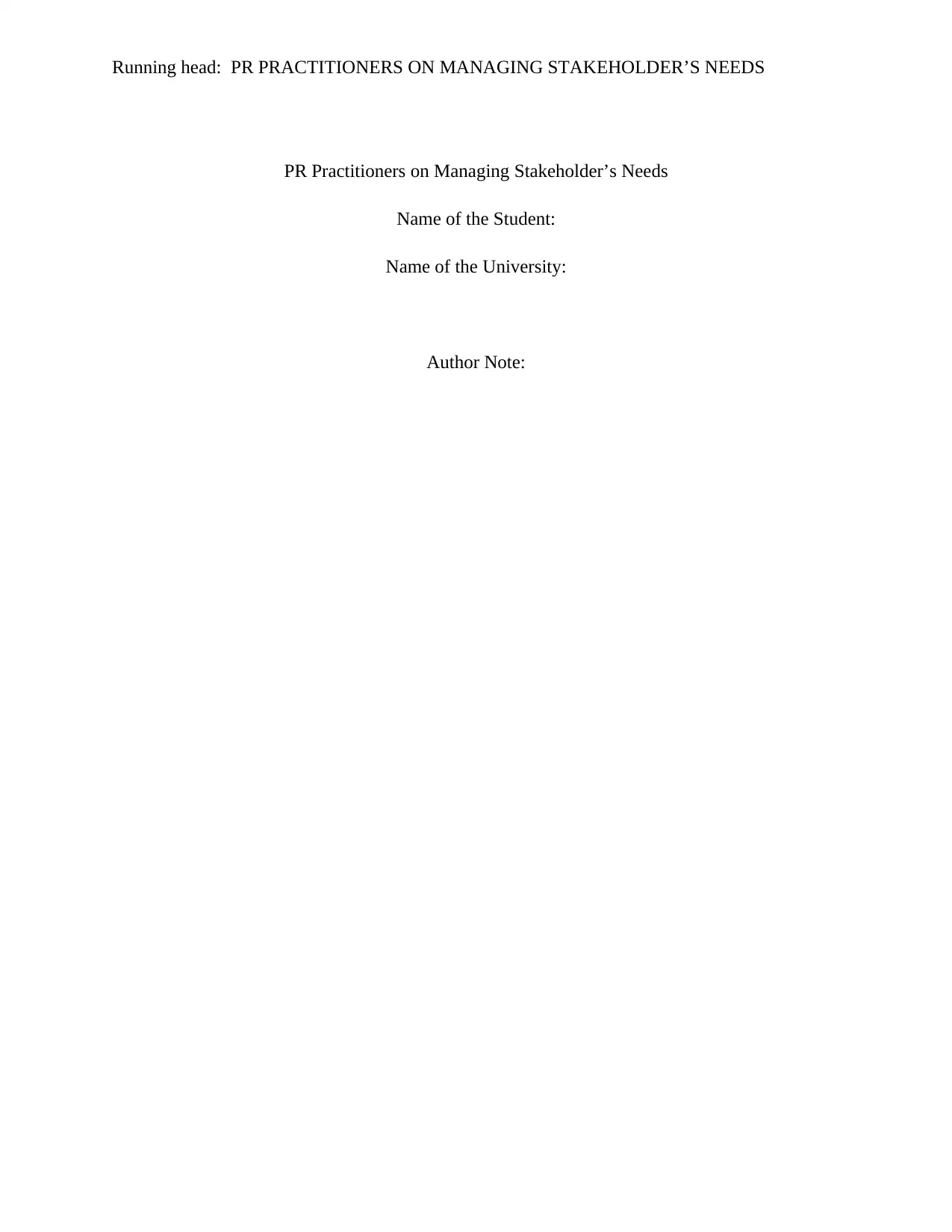
Running head: PR PRACTITIONERS ON MANAGING STAKEHOLDER’S NEEDS
PR Practitioners on Managing Stakeholder’s Needs
Name of the Student:
Name of the University:
Author Note:
PR Practitioners on Managing Stakeholder’s Needs
Name of the Student:
Name of the University:
Author Note:
Paraphrase This Document
Need a fresh take? Get an instant paraphrase of this document with our AI Paraphraser
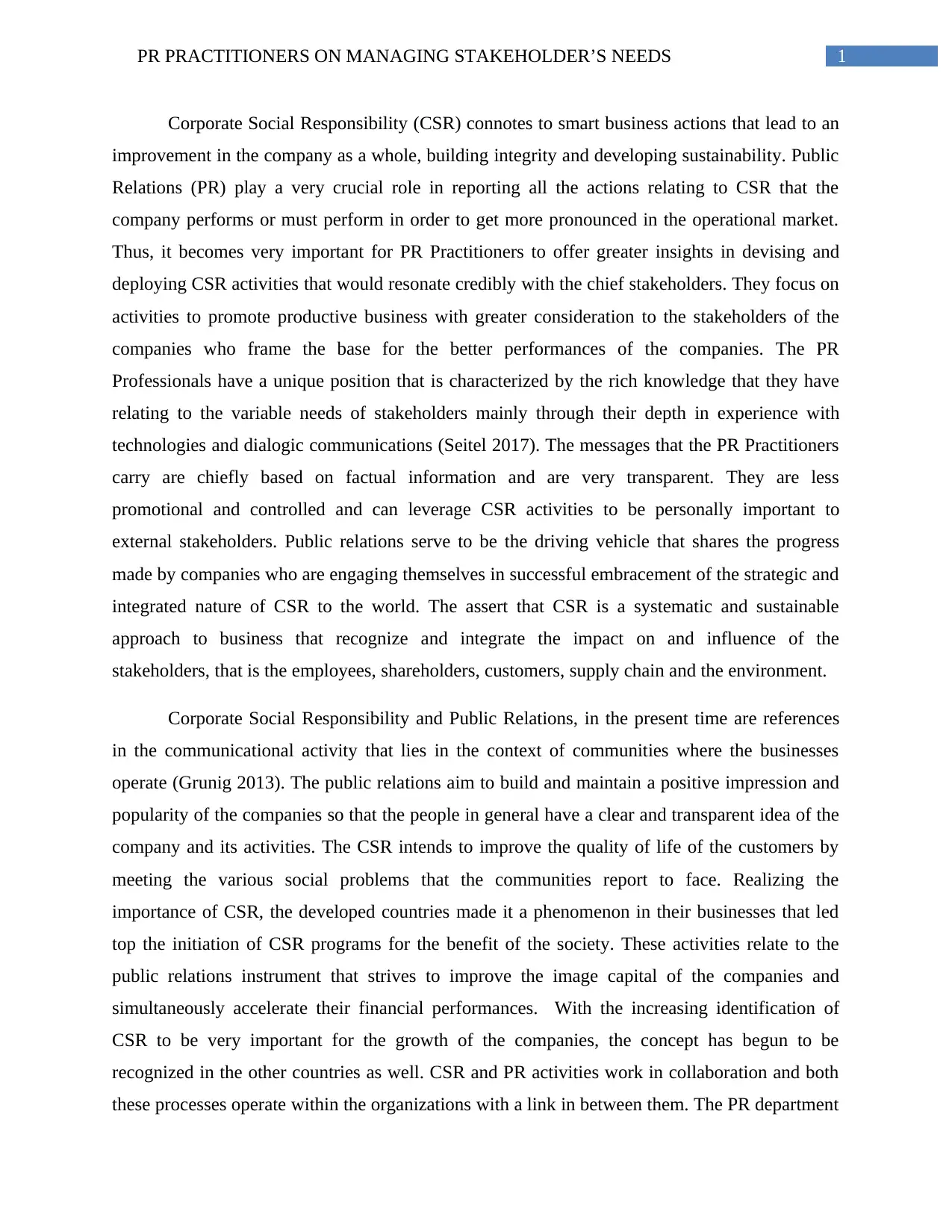
1PR PRACTITIONERS ON MANAGING STAKEHOLDER’S NEEDS
Corporate Social Responsibility (CSR) connotes to smart business actions that lead to an
improvement in the company as a whole, building integrity and developing sustainability. Public
Relations (PR) play a very crucial role in reporting all the actions relating to CSR that the
company performs or must perform in order to get more pronounced in the operational market.
Thus, it becomes very important for PR Practitioners to offer greater insights in devising and
deploying CSR activities that would resonate credibly with the chief stakeholders. They focus on
activities to promote productive business with greater consideration to the stakeholders of the
companies who frame the base for the better performances of the companies. The PR
Professionals have a unique position that is characterized by the rich knowledge that they have
relating to the variable needs of stakeholders mainly through their depth in experience with
technologies and dialogic communications (Seitel 2017). The messages that the PR Practitioners
carry are chiefly based on factual information and are very transparent. They are less
promotional and controlled and can leverage CSR activities to be personally important to
external stakeholders. Public relations serve to be the driving vehicle that shares the progress
made by companies who are engaging themselves in successful embracement of the strategic and
integrated nature of CSR to the world. The assert that CSR is a systematic and sustainable
approach to business that recognize and integrate the impact on and influence of the
stakeholders, that is the employees, shareholders, customers, supply chain and the environment.
Corporate Social Responsibility and Public Relations, in the present time are references
in the communicational activity that lies in the context of communities where the businesses
operate (Grunig 2013). The public relations aim to build and maintain a positive impression and
popularity of the companies so that the people in general have a clear and transparent idea of the
company and its activities. The CSR intends to improve the quality of life of the customers by
meeting the various social problems that the communities report to face. Realizing the
importance of CSR, the developed countries made it a phenomenon in their businesses that led
top the initiation of CSR programs for the benefit of the society. These activities relate to the
public relations instrument that strives to improve the image capital of the companies and
simultaneously accelerate their financial performances. With the increasing identification of
CSR to be very important for the growth of the companies, the concept has begun to be
recognized in the other countries as well. CSR and PR activities work in collaboration and both
these processes operate within the organizations with a link in between them. The PR department
Corporate Social Responsibility (CSR) connotes to smart business actions that lead to an
improvement in the company as a whole, building integrity and developing sustainability. Public
Relations (PR) play a very crucial role in reporting all the actions relating to CSR that the
company performs or must perform in order to get more pronounced in the operational market.
Thus, it becomes very important for PR Practitioners to offer greater insights in devising and
deploying CSR activities that would resonate credibly with the chief stakeholders. They focus on
activities to promote productive business with greater consideration to the stakeholders of the
companies who frame the base for the better performances of the companies. The PR
Professionals have a unique position that is characterized by the rich knowledge that they have
relating to the variable needs of stakeholders mainly through their depth in experience with
technologies and dialogic communications (Seitel 2017). The messages that the PR Practitioners
carry are chiefly based on factual information and are very transparent. They are less
promotional and controlled and can leverage CSR activities to be personally important to
external stakeholders. Public relations serve to be the driving vehicle that shares the progress
made by companies who are engaging themselves in successful embracement of the strategic and
integrated nature of CSR to the world. The assert that CSR is a systematic and sustainable
approach to business that recognize and integrate the impact on and influence of the
stakeholders, that is the employees, shareholders, customers, supply chain and the environment.
Corporate Social Responsibility and Public Relations, in the present time are references
in the communicational activity that lies in the context of communities where the businesses
operate (Grunig 2013). The public relations aim to build and maintain a positive impression and
popularity of the companies so that the people in general have a clear and transparent idea of the
company and its activities. The CSR intends to improve the quality of life of the customers by
meeting the various social problems that the communities report to face. Realizing the
importance of CSR, the developed countries made it a phenomenon in their businesses that led
top the initiation of CSR programs for the benefit of the society. These activities relate to the
public relations instrument that strives to improve the image capital of the companies and
simultaneously accelerate their financial performances. With the increasing identification of
CSR to be very important for the growth of the companies, the concept has begun to be
recognized in the other countries as well. CSR and PR activities work in collaboration and both
these processes operate within the organizations with a link in between them. The PR department
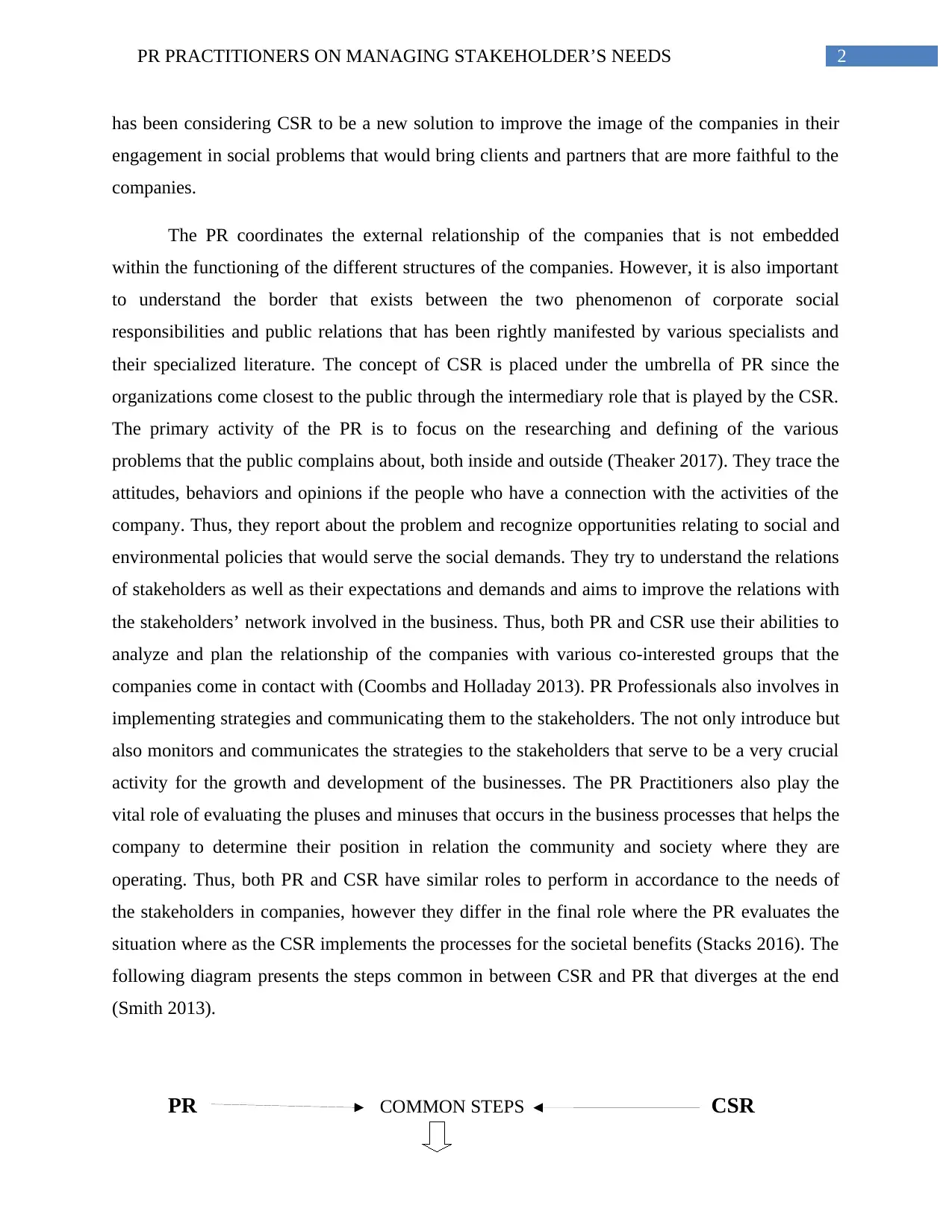
2PR PRACTITIONERS ON MANAGING STAKEHOLDER’S NEEDS
has been considering CSR to be a new solution to improve the image of the companies in their
engagement in social problems that would bring clients and partners that are more faithful to the
companies.
The PR coordinates the external relationship of the companies that is not embedded
within the functioning of the different structures of the companies. However, it is also important
to understand the border that exists between the two phenomenon of corporate social
responsibilities and public relations that has been rightly manifested by various specialists and
their specialized literature. The concept of CSR is placed under the umbrella of PR since the
organizations come closest to the public through the intermediary role that is played by the CSR.
The primary activity of the PR is to focus on the researching and defining of the various
problems that the public complains about, both inside and outside (Theaker 2017). They trace the
attitudes, behaviors and opinions if the people who have a connection with the activities of the
company. Thus, they report about the problem and recognize opportunities relating to social and
environmental policies that would serve the social demands. They try to understand the relations
of stakeholders as well as their expectations and demands and aims to improve the relations with
the stakeholders’ network involved in the business. Thus, both PR and CSR use their abilities to
analyze and plan the relationship of the companies with various co-interested groups that the
companies come in contact with (Coombs and Holladay 2013). PR Professionals also involves in
implementing strategies and communicating them to the stakeholders. The not only introduce but
also monitors and communicates the strategies to the stakeholders that serve to be a very crucial
activity for the growth and development of the businesses. The PR Practitioners also play the
vital role of evaluating the pluses and minuses that occurs in the business processes that helps the
company to determine their position in relation the community and society where they are
operating. Thus, both PR and CSR have similar roles to perform in accordance to the needs of
the stakeholders in companies, however they differ in the final role where the PR evaluates the
situation where as the CSR implements the processes for the societal benefits (Stacks 2016). The
following diagram presents the steps common in between CSR and PR that diverges at the end
(Smith 2013).
PR COMMON STEPS CSR
has been considering CSR to be a new solution to improve the image of the companies in their
engagement in social problems that would bring clients and partners that are more faithful to the
companies.
The PR coordinates the external relationship of the companies that is not embedded
within the functioning of the different structures of the companies. However, it is also important
to understand the border that exists between the two phenomenon of corporate social
responsibilities and public relations that has been rightly manifested by various specialists and
their specialized literature. The concept of CSR is placed under the umbrella of PR since the
organizations come closest to the public through the intermediary role that is played by the CSR.
The primary activity of the PR is to focus on the researching and defining of the various
problems that the public complains about, both inside and outside (Theaker 2017). They trace the
attitudes, behaviors and opinions if the people who have a connection with the activities of the
company. Thus, they report about the problem and recognize opportunities relating to social and
environmental policies that would serve the social demands. They try to understand the relations
of stakeholders as well as their expectations and demands and aims to improve the relations with
the stakeholders’ network involved in the business. Thus, both PR and CSR use their abilities to
analyze and plan the relationship of the companies with various co-interested groups that the
companies come in contact with (Coombs and Holladay 2013). PR Professionals also involves in
implementing strategies and communicating them to the stakeholders. The not only introduce but
also monitors and communicates the strategies to the stakeholders that serve to be a very crucial
activity for the growth and development of the businesses. The PR Practitioners also play the
vital role of evaluating the pluses and minuses that occurs in the business processes that helps the
company to determine their position in relation the community and society where they are
operating. Thus, both PR and CSR have similar roles to perform in accordance to the needs of
the stakeholders in companies, however they differ in the final role where the PR evaluates the
situation where as the CSR implements the processes for the societal benefits (Stacks 2016). The
following diagram presents the steps common in between CSR and PR that diverges at the end
(Smith 2013).
PR COMMON STEPS CSR
⊘ This is a preview!⊘
Do you want full access?
Subscribe today to unlock all pages.

Trusted by 1+ million students worldwide
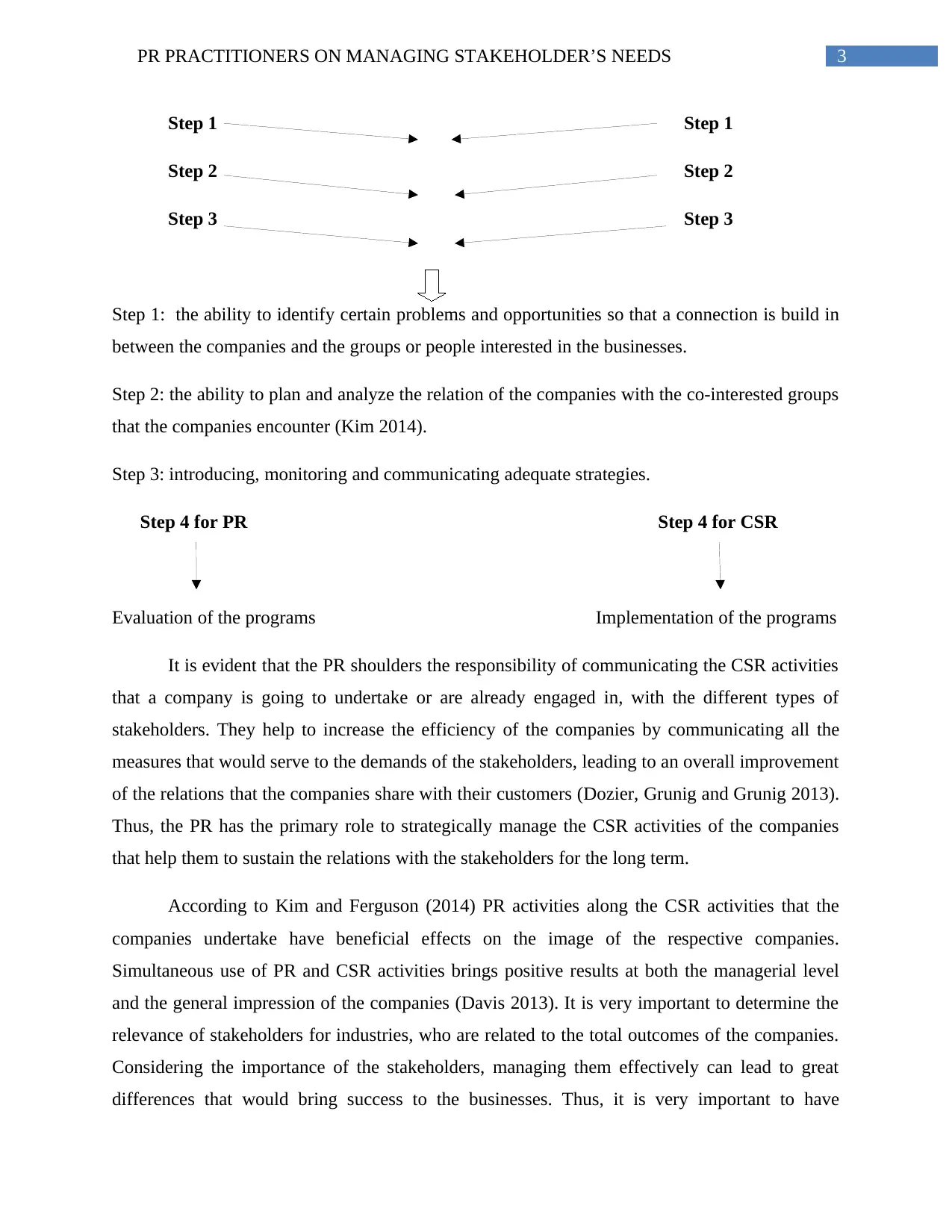
3PR PRACTITIONERS ON MANAGING STAKEHOLDER’S NEEDS
Step 1 Step 1
Step 2 Step 2
Step 3 Step 3
Step 1: the ability to identify certain problems and opportunities so that a connection is build in
between the companies and the groups or people interested in the businesses.
Step 2: the ability to plan and analyze the relation of the companies with the co-interested groups
that the companies encounter (Kim 2014).
Step 3: introducing, monitoring and communicating adequate strategies.
Step 4 for PR Step 4 for CSR
Evaluation of the programs Implementation of the programs
It is evident that the PR shoulders the responsibility of communicating the CSR activities
that a company is going to undertake or are already engaged in, with the different types of
stakeholders. They help to increase the efficiency of the companies by communicating all the
measures that would serve to the demands of the stakeholders, leading to an overall improvement
of the relations that the companies share with their customers (Dozier, Grunig and Grunig 2013).
Thus, the PR has the primary role to strategically manage the CSR activities of the companies
that help them to sustain the relations with the stakeholders for the long term.
According to Kim and Ferguson (2014) PR activities along the CSR activities that the
companies undertake have beneficial effects on the image of the respective companies.
Simultaneous use of PR and CSR activities brings positive results at both the managerial level
and the general impression of the companies (Davis 2013). It is very important to determine the
relevance of stakeholders for industries, who are related to the total outcomes of the companies.
Considering the importance of the stakeholders, managing them effectively can lead to great
differences that would bring success to the businesses. Thus, it is very important to have
Step 1 Step 1
Step 2 Step 2
Step 3 Step 3
Step 1: the ability to identify certain problems and opportunities so that a connection is build in
between the companies and the groups or people interested in the businesses.
Step 2: the ability to plan and analyze the relation of the companies with the co-interested groups
that the companies encounter (Kim 2014).
Step 3: introducing, monitoring and communicating adequate strategies.
Step 4 for PR Step 4 for CSR
Evaluation of the programs Implementation of the programs
It is evident that the PR shoulders the responsibility of communicating the CSR activities
that a company is going to undertake or are already engaged in, with the different types of
stakeholders. They help to increase the efficiency of the companies by communicating all the
measures that would serve to the demands of the stakeholders, leading to an overall improvement
of the relations that the companies share with their customers (Dozier, Grunig and Grunig 2013).
Thus, the PR has the primary role to strategically manage the CSR activities of the companies
that help them to sustain the relations with the stakeholders for the long term.
According to Kim and Ferguson (2014) PR activities along the CSR activities that the
companies undertake have beneficial effects on the image of the respective companies.
Simultaneous use of PR and CSR activities brings positive results at both the managerial level
and the general impression of the companies (Davis 2013). It is very important to determine the
relevance of stakeholders for industries, who are related to the total outcomes of the companies.
Considering the importance of the stakeholders, managing them effectively can lead to great
differences that would bring success to the businesses. Thus, it is very important to have
Paraphrase This Document
Need a fresh take? Get an instant paraphrase of this document with our AI Paraphraser
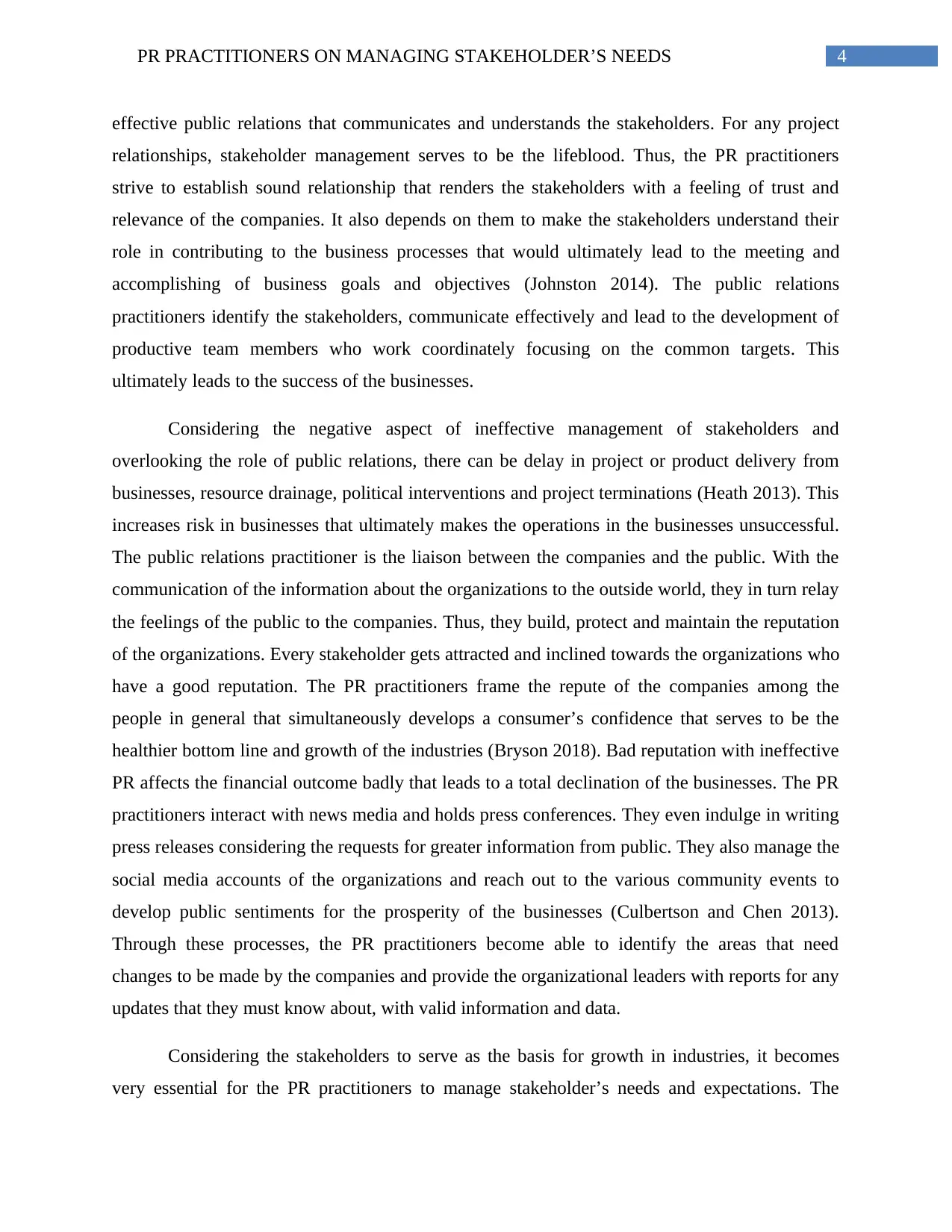
4PR PRACTITIONERS ON MANAGING STAKEHOLDER’S NEEDS
effective public relations that communicates and understands the stakeholders. For any project
relationships, stakeholder management serves to be the lifeblood. Thus, the PR practitioners
strive to establish sound relationship that renders the stakeholders with a feeling of trust and
relevance of the companies. It also depends on them to make the stakeholders understand their
role in contributing to the business processes that would ultimately lead to the meeting and
accomplishing of business goals and objectives (Johnston 2014). The public relations
practitioners identify the stakeholders, communicate effectively and lead to the development of
productive team members who work coordinately focusing on the common targets. This
ultimately leads to the success of the businesses.
Considering the negative aspect of ineffective management of stakeholders and
overlooking the role of public relations, there can be delay in project or product delivery from
businesses, resource drainage, political interventions and project terminations (Heath 2013). This
increases risk in businesses that ultimately makes the operations in the businesses unsuccessful.
The public relations practitioner is the liaison between the companies and the public. With the
communication of the information about the organizations to the outside world, they in turn relay
the feelings of the public to the companies. Thus, they build, protect and maintain the reputation
of the organizations. Every stakeholder gets attracted and inclined towards the organizations who
have a good reputation. The PR practitioners frame the repute of the companies among the
people in general that simultaneously develops a consumer’s confidence that serves to be the
healthier bottom line and growth of the industries (Bryson 2018). Bad reputation with ineffective
PR affects the financial outcome badly that leads to a total declination of the businesses. The PR
practitioners interact with news media and holds press conferences. They even indulge in writing
press releases considering the requests for greater information from public. They also manage the
social media accounts of the organizations and reach out to the various community events to
develop public sentiments for the prosperity of the businesses (Culbertson and Chen 2013).
Through these processes, the PR practitioners become able to identify the areas that need
changes to be made by the companies and provide the organizational leaders with reports for any
updates that they must know about, with valid information and data.
Considering the stakeholders to serve as the basis for growth in industries, it becomes
very essential for the PR practitioners to manage stakeholder’s needs and expectations. The
effective public relations that communicates and understands the stakeholders. For any project
relationships, stakeholder management serves to be the lifeblood. Thus, the PR practitioners
strive to establish sound relationship that renders the stakeholders with a feeling of trust and
relevance of the companies. It also depends on them to make the stakeholders understand their
role in contributing to the business processes that would ultimately lead to the meeting and
accomplishing of business goals and objectives (Johnston 2014). The public relations
practitioners identify the stakeholders, communicate effectively and lead to the development of
productive team members who work coordinately focusing on the common targets. This
ultimately leads to the success of the businesses.
Considering the negative aspect of ineffective management of stakeholders and
overlooking the role of public relations, there can be delay in project or product delivery from
businesses, resource drainage, political interventions and project terminations (Heath 2013). This
increases risk in businesses that ultimately makes the operations in the businesses unsuccessful.
The public relations practitioner is the liaison between the companies and the public. With the
communication of the information about the organizations to the outside world, they in turn relay
the feelings of the public to the companies. Thus, they build, protect and maintain the reputation
of the organizations. Every stakeholder gets attracted and inclined towards the organizations who
have a good reputation. The PR practitioners frame the repute of the companies among the
people in general that simultaneously develops a consumer’s confidence that serves to be the
healthier bottom line and growth of the industries (Bryson 2018). Bad reputation with ineffective
PR affects the financial outcome badly that leads to a total declination of the businesses. The PR
practitioners interact with news media and holds press conferences. They even indulge in writing
press releases considering the requests for greater information from public. They also manage the
social media accounts of the organizations and reach out to the various community events to
develop public sentiments for the prosperity of the businesses (Culbertson and Chen 2013).
Through these processes, the PR practitioners become able to identify the areas that need
changes to be made by the companies and provide the organizational leaders with reports for any
updates that they must know about, with valid information and data.
Considering the stakeholders to serve as the basis for growth in industries, it becomes
very essential for the PR practitioners to manage stakeholder’s needs and expectations. The
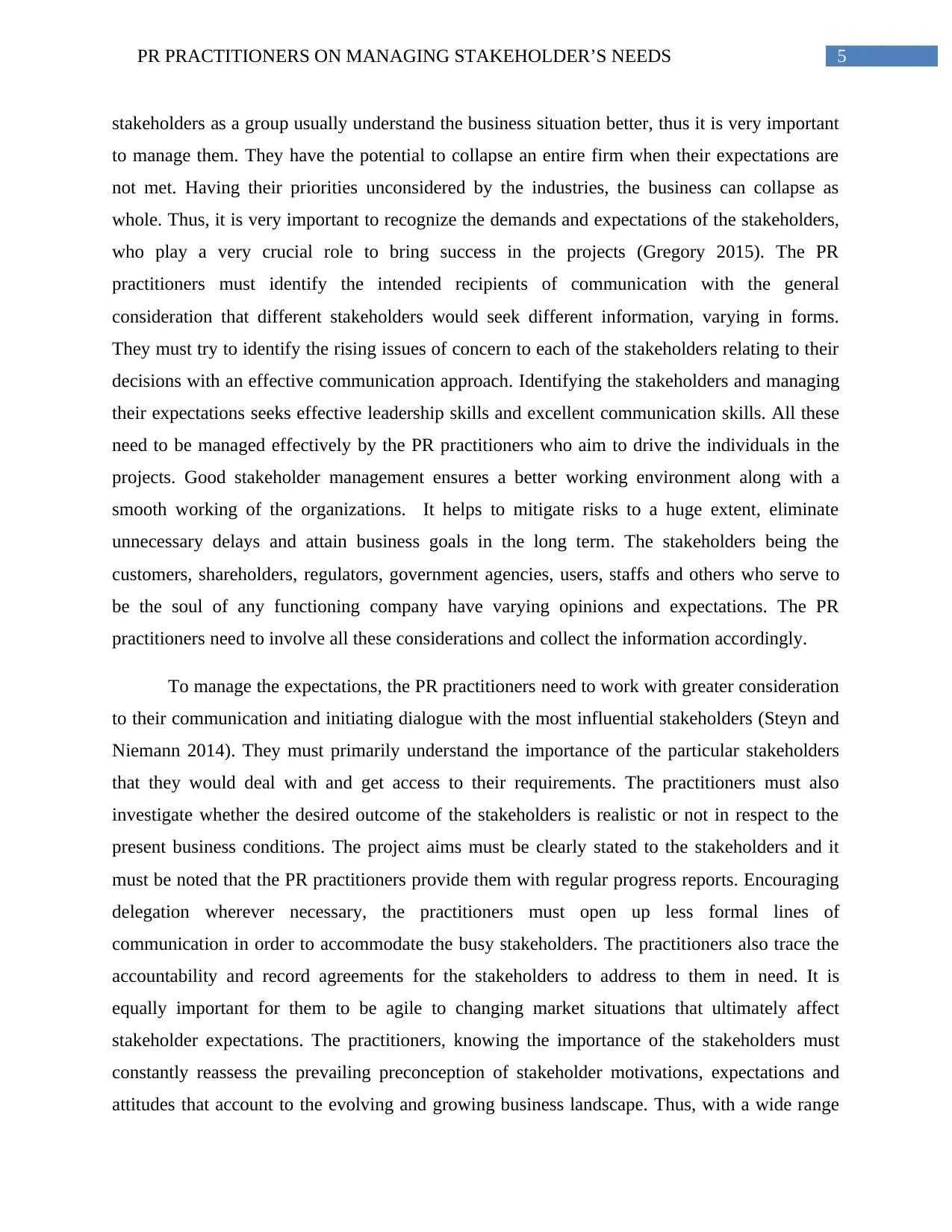
5PR PRACTITIONERS ON MANAGING STAKEHOLDER’S NEEDS
stakeholders as a group usually understand the business situation better, thus it is very important
to manage them. They have the potential to collapse an entire firm when their expectations are
not met. Having their priorities unconsidered by the industries, the business can collapse as
whole. Thus, it is very important to recognize the demands and expectations of the stakeholders,
who play a very crucial role to bring success in the projects (Gregory 2015). The PR
practitioners must identify the intended recipients of communication with the general
consideration that different stakeholders would seek different information, varying in forms.
They must try to identify the rising issues of concern to each of the stakeholders relating to their
decisions with an effective communication approach. Identifying the stakeholders and managing
their expectations seeks effective leadership skills and excellent communication skills. All these
need to be managed effectively by the PR practitioners who aim to drive the individuals in the
projects. Good stakeholder management ensures a better working environment along with a
smooth working of the organizations. It helps to mitigate risks to a huge extent, eliminate
unnecessary delays and attain business goals in the long term. The stakeholders being the
customers, shareholders, regulators, government agencies, users, staffs and others who serve to
be the soul of any functioning company have varying opinions and expectations. The PR
practitioners need to involve all these considerations and collect the information accordingly.
To manage the expectations, the PR practitioners need to work with greater consideration
to their communication and initiating dialogue with the most influential stakeholders (Steyn and
Niemann 2014). They must primarily understand the importance of the particular stakeholders
that they would deal with and get access to their requirements. The practitioners must also
investigate whether the desired outcome of the stakeholders is realistic or not in respect to the
present business conditions. The project aims must be clearly stated to the stakeholders and it
must be noted that the PR practitioners provide them with regular progress reports. Encouraging
delegation wherever necessary, the practitioners must open up less formal lines of
communication in order to accommodate the busy stakeholders. The practitioners also trace the
accountability and record agreements for the stakeholders to address to them in need. It is
equally important for them to be agile to changing market situations that ultimately affect
stakeholder expectations. The practitioners, knowing the importance of the stakeholders must
constantly reassess the prevailing preconception of stakeholder motivations, expectations and
attitudes that account to the evolving and growing business landscape. Thus, with a wide range
stakeholders as a group usually understand the business situation better, thus it is very important
to manage them. They have the potential to collapse an entire firm when their expectations are
not met. Having their priorities unconsidered by the industries, the business can collapse as
whole. Thus, it is very important to recognize the demands and expectations of the stakeholders,
who play a very crucial role to bring success in the projects (Gregory 2015). The PR
practitioners must identify the intended recipients of communication with the general
consideration that different stakeholders would seek different information, varying in forms.
They must try to identify the rising issues of concern to each of the stakeholders relating to their
decisions with an effective communication approach. Identifying the stakeholders and managing
their expectations seeks effective leadership skills and excellent communication skills. All these
need to be managed effectively by the PR practitioners who aim to drive the individuals in the
projects. Good stakeholder management ensures a better working environment along with a
smooth working of the organizations. It helps to mitigate risks to a huge extent, eliminate
unnecessary delays and attain business goals in the long term. The stakeholders being the
customers, shareholders, regulators, government agencies, users, staffs and others who serve to
be the soul of any functioning company have varying opinions and expectations. The PR
practitioners need to involve all these considerations and collect the information accordingly.
To manage the expectations, the PR practitioners need to work with greater consideration
to their communication and initiating dialogue with the most influential stakeholders (Steyn and
Niemann 2014). They must primarily understand the importance of the particular stakeholders
that they would deal with and get access to their requirements. The practitioners must also
investigate whether the desired outcome of the stakeholders is realistic or not in respect to the
present business conditions. The project aims must be clearly stated to the stakeholders and it
must be noted that the PR practitioners provide them with regular progress reports. Encouraging
delegation wherever necessary, the practitioners must open up less formal lines of
communication in order to accommodate the busy stakeholders. The practitioners also trace the
accountability and record agreements for the stakeholders to address to them in need. It is
equally important for them to be agile to changing market situations that ultimately affect
stakeholder expectations. The practitioners, knowing the importance of the stakeholders must
constantly reassess the prevailing preconception of stakeholder motivations, expectations and
attitudes that account to the evolving and growing business landscape. Thus, with a wide range
⊘ This is a preview!⊘
Do you want full access?
Subscribe today to unlock all pages.

Trusted by 1+ million students worldwide
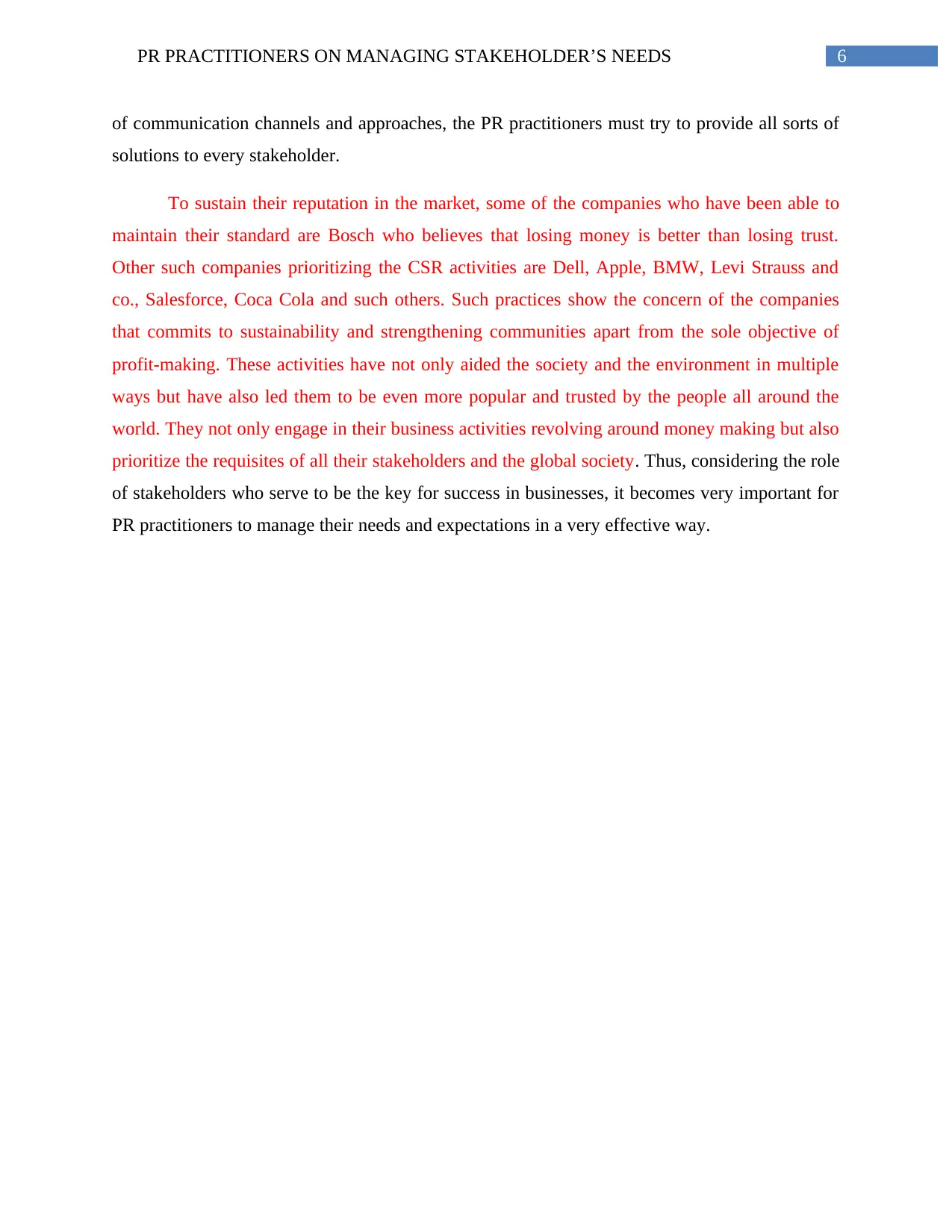
6PR PRACTITIONERS ON MANAGING STAKEHOLDER’S NEEDS
of communication channels and approaches, the PR practitioners must try to provide all sorts of
solutions to every stakeholder.
To sustain their reputation in the market, some of the companies who have been able to
maintain their standard are Bosch who believes that losing money is better than losing trust.
Other such companies prioritizing the CSR activities are Dell, Apple, BMW, Levi Strauss and
co., Salesforce, Coca Cola and such others. Such practices show the concern of the companies
that commits to sustainability and strengthening communities apart from the sole objective of
profit-making. These activities have not only aided the society and the environment in multiple
ways but have also led them to be even more popular and trusted by the people all around the
world. They not only engage in their business activities revolving around money making but also
prioritize the requisites of all their stakeholders and the global society. Thus, considering the role
of stakeholders who serve to be the key for success in businesses, it becomes very important for
PR practitioners to manage their needs and expectations in a very effective way.
of communication channels and approaches, the PR practitioners must try to provide all sorts of
solutions to every stakeholder.
To sustain their reputation in the market, some of the companies who have been able to
maintain their standard are Bosch who believes that losing money is better than losing trust.
Other such companies prioritizing the CSR activities are Dell, Apple, BMW, Levi Strauss and
co., Salesforce, Coca Cola and such others. Such practices show the concern of the companies
that commits to sustainability and strengthening communities apart from the sole objective of
profit-making. These activities have not only aided the society and the environment in multiple
ways but have also led them to be even more popular and trusted by the people all around the
world. They not only engage in their business activities revolving around money making but also
prioritize the requisites of all their stakeholders and the global society. Thus, considering the role
of stakeholders who serve to be the key for success in businesses, it becomes very important for
PR practitioners to manage their needs and expectations in a very effective way.
Paraphrase This Document
Need a fresh take? Get an instant paraphrase of this document with our AI Paraphraser
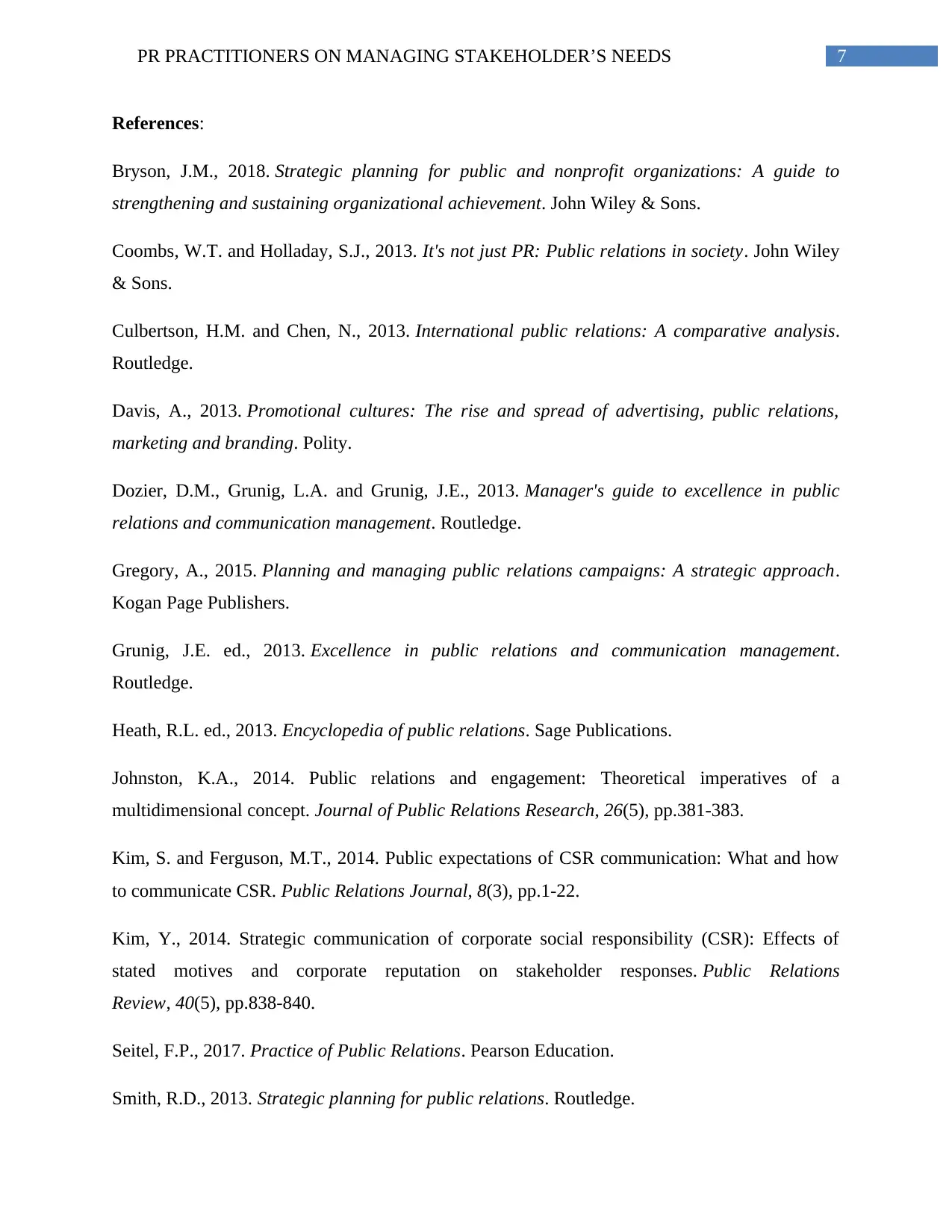
7PR PRACTITIONERS ON MANAGING STAKEHOLDER’S NEEDS
References:
Bryson, J.M., 2018. Strategic planning for public and nonprofit organizations: A guide to
strengthening and sustaining organizational achievement. John Wiley & Sons.
Coombs, W.T. and Holladay, S.J., 2013. It's not just PR: Public relations in society. John Wiley
& Sons.
Culbertson, H.M. and Chen, N., 2013. International public relations: A comparative analysis.
Routledge.
Davis, A., 2013. Promotional cultures: The rise and spread of advertising, public relations,
marketing and branding. Polity.
Dozier, D.M., Grunig, L.A. and Grunig, J.E., 2013. Manager's guide to excellence in public
relations and communication management. Routledge.
Gregory, A., 2015. Planning and managing public relations campaigns: A strategic approach.
Kogan Page Publishers.
Grunig, J.E. ed., 2013. Excellence in public relations and communication management.
Routledge.
Heath, R.L. ed., 2013. Encyclopedia of public relations. Sage Publications.
Johnston, K.A., 2014. Public relations and engagement: Theoretical imperatives of a
multidimensional concept. Journal of Public Relations Research, 26(5), pp.381-383.
Kim, S. and Ferguson, M.T., 2014. Public expectations of CSR communication: What and how
to communicate CSR. Public Relations Journal, 8(3), pp.1-22.
Kim, Y., 2014. Strategic communication of corporate social responsibility (CSR): Effects of
stated motives and corporate reputation on stakeholder responses. Public Relations
Review, 40(5), pp.838-840.
Seitel, F.P., 2017. Practice of Public Relations. Pearson Education.
Smith, R.D., 2013. Strategic planning for public relations. Routledge.
References:
Bryson, J.M., 2018. Strategic planning for public and nonprofit organizations: A guide to
strengthening and sustaining organizational achievement. John Wiley & Sons.
Coombs, W.T. and Holladay, S.J., 2013. It's not just PR: Public relations in society. John Wiley
& Sons.
Culbertson, H.M. and Chen, N., 2013. International public relations: A comparative analysis.
Routledge.
Davis, A., 2013. Promotional cultures: The rise and spread of advertising, public relations,
marketing and branding. Polity.
Dozier, D.M., Grunig, L.A. and Grunig, J.E., 2013. Manager's guide to excellence in public
relations and communication management. Routledge.
Gregory, A., 2015. Planning and managing public relations campaigns: A strategic approach.
Kogan Page Publishers.
Grunig, J.E. ed., 2013. Excellence in public relations and communication management.
Routledge.
Heath, R.L. ed., 2013. Encyclopedia of public relations. Sage Publications.
Johnston, K.A., 2014. Public relations and engagement: Theoretical imperatives of a
multidimensional concept. Journal of Public Relations Research, 26(5), pp.381-383.
Kim, S. and Ferguson, M.T., 2014. Public expectations of CSR communication: What and how
to communicate CSR. Public Relations Journal, 8(3), pp.1-22.
Kim, Y., 2014. Strategic communication of corporate social responsibility (CSR): Effects of
stated motives and corporate reputation on stakeholder responses. Public Relations
Review, 40(5), pp.838-840.
Seitel, F.P., 2017. Practice of Public Relations. Pearson Education.
Smith, R.D., 2013. Strategic planning for public relations. Routledge.
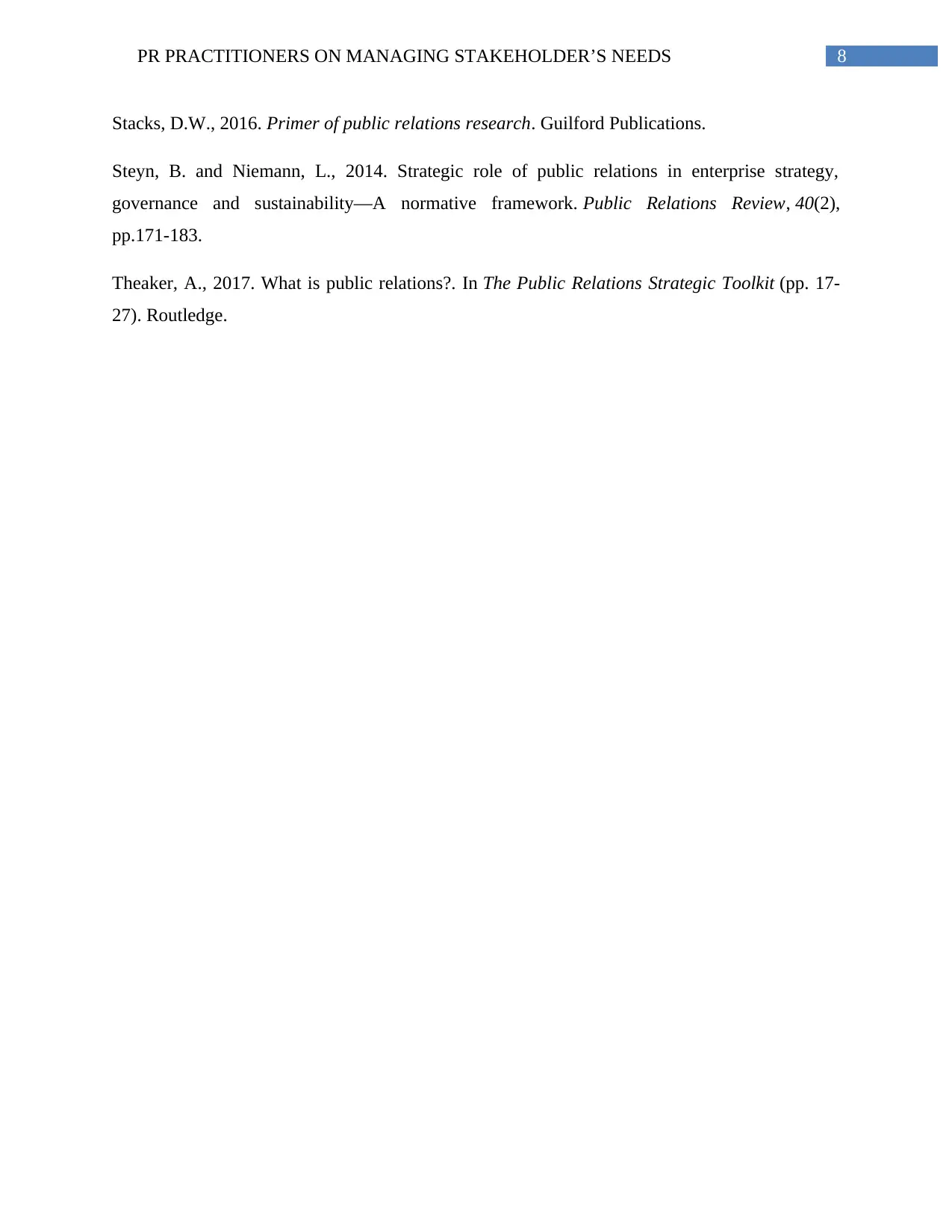
8PR PRACTITIONERS ON MANAGING STAKEHOLDER’S NEEDS
Stacks, D.W., 2016. Primer of public relations research. Guilford Publications.
Steyn, B. and Niemann, L., 2014. Strategic role of public relations in enterprise strategy,
governance and sustainability—A normative framework. Public Relations Review, 40(2),
pp.171-183.
Theaker, A., 2017. What is public relations?. In The Public Relations Strategic Toolkit (pp. 17-
27). Routledge.
Stacks, D.W., 2016. Primer of public relations research. Guilford Publications.
Steyn, B. and Niemann, L., 2014. Strategic role of public relations in enterprise strategy,
governance and sustainability—A normative framework. Public Relations Review, 40(2),
pp.171-183.
Theaker, A., 2017. What is public relations?. In The Public Relations Strategic Toolkit (pp. 17-
27). Routledge.
⊘ This is a preview!⊘
Do you want full access?
Subscribe today to unlock all pages.

Trusted by 1+ million students worldwide
1 out of 9
Related Documents
Your All-in-One AI-Powered Toolkit for Academic Success.
+13062052269
info@desklib.com
Available 24*7 on WhatsApp / Email
![[object Object]](/_next/static/media/star-bottom.7253800d.svg)
Unlock your academic potential
Copyright © 2020–2025 A2Z Services. All Rights Reserved. Developed and managed by ZUCOL.




